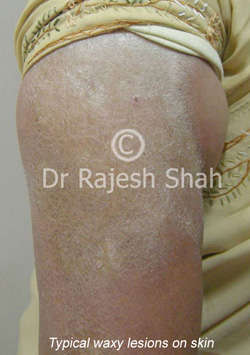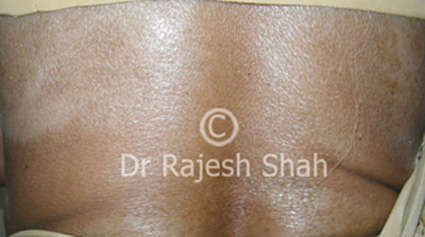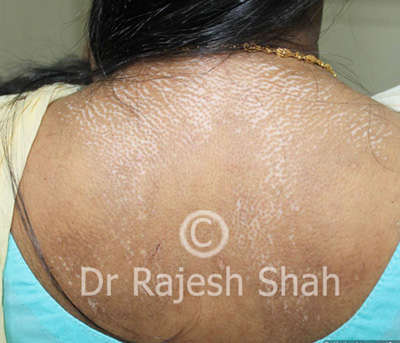Morphea Scleroderma Homeopathic Treatment and Its Homeopathy Medicine
What is Scleroderma?
 Scleroderma is a disease that primarily affects the skin producing abnormal hardening of tissues.
Scleroderma is a disease that primarily affects the skin producing abnormal hardening of tissues.
The exact cause of scleroderma is unknown, however, it is termed an autoimmune disease, which triggers an overproduction of collagen in tissues and damages blood vessels.
Collagen is a protein found in connective tissues of the skin, joints, tendons, and internal organs such as lungs, heart, liver, kidneys, etc. Hence the severity of the disease depends on which parts of the body are affected.
Overproduction of collagen leads to hardening of the affected parts thereby hampering the normal functioning of that affected organ or part.
Incidence:
It is widely considered a disease of middle age from 30 to 50 years although it is seen in children as well. The disease presentation in children is quite different from those of adults.
It shows marked affinity towards females; about 75% of cases are females.
Family members of those with scleroderma or other connective tissue diseases like Lupus are more prone to get scleroderma.
Scleroderma is not infectious, contagious, or malignant.
Types of scleroderma:
Scleroderma can be classified into Localized and Systemic scleroderma.
Localized scleroderma has two types namely Morphea and Linear scleroderma. Systemic scleroderma is further classified into diffuse and limited scleroderma.

01 Localized scleroderma:
This form of scleroderma usually affects the skin but it may spread to muscles and bones. It usually affects the skin of hands and face causing hardening of the skin, the hard skin patches are discolored in appearance.
This is termed as a mild form of scleroderma where internal organs are not affected. Rarely localized scleroderma develops into systemic (generalized) scleroderma.
a Morphea: It is a form of localized scleroderma where waxy patches appear on the skin which vary in size and color. Thickened skin is noticed under these patches. This form is more often seen in young adults.
b Linear scleroderma: It is a form of localized scleroderma most commonly seen in children. It shows up as a line or streak of hardened waxy skin on single parts of the body such as the arm or leg or on the forehead. It also affects the mobility of joints underneath the skin, which is affected and retards the growth of the affected parts in children.
02 Systemic scleroderma:
Systemic scleroderma is also known as systemic sclerosis as it affects more than one system of the body such as muscles, lungs, heart, liver, kidneys, and gastrointestinal tract. It is termed as an autoimmune connective tissue disorder where connective tissues of different organs are affected becoming hard and functioning less than normal.
In diffuse scleroderma, skin thickening happens rapidly and involves a larger area whereas in limited scleroderma skin thickening is confined to lesser areas like fingers, hands, and face and develops slowly over the years.
Symptoms of scleroderma:
- Raynaud's phenomenon: One of the earliest signs of scleroderma may be an exaggerated response to cold temperatures or emotional distress. Such a response may lead to constriction of the blood vessels of fingers and toes, sometimes the ear, nose, and the tip of the tongue. This constriction of blood vessels causes color changes in the skin to white or blue. It is sometimes painful.
- The swelling of fingers is another earlier sign seen in scleroderma. It is most commonly seen in the morning due to inactivity at night.
- Pain and stiffness of joints: Pain, stiffness, swelling, and warmth over the joints are commonly seen accompanied by muscle pain and weakness. Joint contractures are also noticed in a few cases where the joints become fixed in a flexed position and a movement becomes very painful. In a few cases, muscle weakness leads to carpal tunnel syndrome.
- Skin thickening or hardening with itching.
- Ulceration: It is most commonly seen over the fingertips. These ulcerations are difficult to heal due to poor circulation. Ulceration is caused due to excessive dryness of the skin. Ulcerations must be treated with immediate effect as they may lead to infections, which become more challenging to treat.
- Calcium deposits can be seen just below the skin in the form of lumps. These lumps break to be seen as chalky white material and are prone to infections.
- Telangiectasia: This is one of the specific signs of scleroderma where blood vessels near the surface of the skin become visible as small red spots. Common places are fingers, palms, face, and lips. These spots have a tendency to disappear on applying pressure but return once the pressure is released.
- Sweat pores decrease on affected parts.
- There may be a decrease in the hair on the affected parts.
- Sometimes the affected parts look like tanned skin due to pigmentation.
- Acid reflux and swallowing difficulties are common in many patients.
- Dryness in the eyes or mouth is due to a decrease in the secretion of salivary and tear glands.
- Skin hardening over the face may result in difficulty in opening the mouth thereby difficulty in maintaining dental hygiene.
- In severe cases, lungs and kidneys are affected.
- Mild to severe Fatigue. Limiting your activities will help immensely.
- High blood pressure.
- Emotionally patients with scleroderma may feel shocked, feared, angry, helpless, guilty, etc. Professional counseling is helpful for the person suffering from scleroderma and his or her family to cope with scleroderma.
Diagnosis:
There is no single diagnostic test for scleroderma. However, an experienced doctor can diagnose this condition by taking a thorough past and present medical history and thorough clinical examination.
ANA (Anti Nuclear Antibodies) is a blood test that helps to differentiate types of scleroderma.
While diagnosing scleroderma it is important to determine the extent and severity of the disease to chalk out the treatment plan accordingly.

Treatment for Scleroderma:
Early diagnosis and timely treatment can help long-term management of scleroderma; whereby irreversible damage could be avoided. Earlier the better.
There is no complete cure for scleroderma as of now. However, that does not mean that there is no hope. Morphea Scleroderma which is also localized scleroderma can be controlled before it converts into Systemic Scleroderma. Morphea Scleroderma natural treatment is possible. In this way, Scleroderma needs to be controlled and kept under check. Also, some of the symptoms of Scleroderma can be very well reduced with medicines. Morphea Scleroderma Homeopathy Treatment Plan needs to be focused on controlling it in order to improve quality of life.
Developing an individualized focused Morphea Scleroderma natural treatment plan is desirable in most cases of scleroderma based on the symptoms.
Scleroderma is a disease affecting many organs at a time and showing variable symptoms from patient to patient thus the treatment plan must be holistic and individualistic based on the individual patient with a major focus on the affected organ.
The morphea treatment homeopathy is aimed at improving the quality of life by reducing the symptoms like pain, improving nutrition, and considering the emotional aspect of the disease fear, depression, and social withdrawal caused by disfigurement.
Conventional medicines for scleroderma:
Symptomatic relief is achieved with conventional treatment.
Some important tips:
- Skin thickening is treated with drugs like D- penicillamine, interferon, or cyclophosphamide.
- Raynaud's phenomenon is treated with vasodilators such as calcium channel blockers.
- If a person develops ulcers it is treated with phosphodiesterase.
- The cases with hypertension are treated with antihypertensive medicines.
- Acid reflux is treated with antacids.
- Corticosteroids are prescribed in the cases affecting lungs or kidneys.
- Patients suffering from scleroderma are always advised to keep their extremities warm by covering them with gloves and socks. Particular care must be taken while exposed to cold weather, in an air conditioner, or while opening the refrigerator.
- It is advisable to avoid emotional stress.
- At the time of such an episode, the patient may take a warm bath or use room heaters to tackle the episode. Rubbing or massaging the hands and feet helps in restoring blood circulation.
- Tobacco can affect the blood vessels badly in this condition. Smoking is strictly prohibited as it may increase or initiate Raynaud's phenomenon.
- Excessive bathing or hand washing should be avoided.
- Keeping skin moisturized all the time is helpful.
Homeopathic treatment for scleroderma:
Scleroderma is a disease of connective tissues and it is governed by genetic and immunological factors. Homeopathy works at the immunological level and the medicines are decided on the basis of the patient's genetic tendencies leading to this disease.
Scleroderma should be detected at an early stage before it spreads and attacks the systemic parts of the body. A targeted solution with a morphea scleroderma homeopathy treatment plan can be considered at an early stage. Homeopathic treatment is effective for scleroderma especially as a supportive measure to control the disease process and for getting some relief in some of the stubborn symptoms such as Raynaud's phenomenon, painfulness, etc.
Morphea Scleroderma Homeopathy treatment is effective for scleroderma especially as a supportive measure to control the disease process and for getting some relief in some of the stubborn symptoms such as Raynaud's phenomenon, painfulness, etc. In our limited experience at Life Force, (we have treated about six cases by April 2014), where we have not observed a reversal of scleroderma. We have observed relief in symptoms. Dr. Shah would like to strongly recommend homeopathic medicines as a part of treatment for this disease, along with conventional medicines.
Written & Approved by-
Dr. Rajesh Shah
M.D. (Hom.)